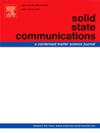InSb/Janus MoSSe van der Waals heterostructure: First-principles calculation study of electronic structure and optical properties
IF 2.1
4区 物理与天体物理
Q3 PHYSICS, CONDENSED MATTER
引用次数: 0
Abstract
The Janus MoSSe and InSb monolayers exhibit direct bandgaps of 1.60 eV and 0.70 eV, respectively, positioning them as promising candidates for optoelectronic applications. The InSb/Janus MoSSe van der Waals heterojunction is characterized as a direct bandgap semiconductor with a bandgap of 0.56 eV, classifying it as a Type II heterojunction. Computational density of states analysis reveals that the valence band maximum is predominantly derived from the Sb 5s orbital. In contrast, the conduction band minimum is attributed to the hybridization of Mo 4d orbitals. As the interlayer spacing increases, the band gap gradually decreases and stabilizes at approximately 0.36 eV, whereas a reduction in spacing progressively narrows the band gap, ultimately inducing metallic characteristics. The work function of the Janus MoSSe monolayer is determined to be 5.57 eV, contrasting with the 4.79 eV work function of the InSb monolayer, yielding a composite work function of 5.15 eV for the heterojunction. Differential charge density analysis indicates electron transfer from the InSb monolayer to the Janus MoSSe layer, facilitating charge separation and transfer. Optical property investigations demonstrate that the InSb monolayer predominantly absorbs in the infrared and visible spectra. In contrast, the Janus MoSSe monolayer exhibits significant absorption in the visible and near-ultraviolet regions. Notably, the InSb/Janus MoSSe heterojunction synergistically integrates the optical advantages of its constituents, enabling broad-spectrum photon absorption spanning the infrared, visible, near-ultraviolet, and far-ultraviolet regions. These findings provide valuable theoretical insights, paving the way for advanced applications of the InSb/Janus MoSSe van der Waals heterojunction in next-generation optoelectronic devices.
InSb/Janus MoSSe van der Waals异质结构:电子结构和光学性质的第一性原理计算研究
Janus MoSSe和InSb单层分别表现出1.60 eV和0.70 eV的直接带隙,使它们成为光电应用的有希望的候选者。InSb/Janus MoSSe van der Waals异质结的特点是直接带隙半导体,带隙为0.56 eV,归类为II型异质结。计算态密度分析表明,价带最大值主要来自s5s轨道。相反,导带最小值归因于mo4d轨道的杂化。随着层间距的增加,带隙逐渐减小并稳定在0.36 eV左右,而间距的减小使带隙逐渐缩小,最终产生金属特性。Janus MoSSe单层的功函数为5.57 eV,而InSb单层的功函数为4.79 eV,得到异质结的复合功函数为5.15 eV。差分电荷密度分析表明,电子从InSb单层转移到Janus MoSSe层,促进了电荷的分离和转移。光学性质研究表明,InSb单层主要吸收红外和可见光谱。相比之下,Janus MoSSe单层在可见光和近紫外区表现出显著的吸收。值得注意的是,InSb/Janus MoSSe异质结协同集成了其成分的光学优势,实现了跨越红外、可见光、近紫外和远紫外区域的广谱光子吸收。这些发现提供了有价值的理论见解,为InSb/Janus MoSSe范德华异质结在下一代光电器件中的高级应用铺平了道路。
本文章由计算机程序翻译,如有差异,请以英文原文为准。
求助全文
约1分钟内获得全文
求助全文
来源期刊

Solid State Communications
物理-物理:凝聚态物理
CiteScore
3.40
自引率
4.80%
发文量
287
审稿时长
51 days
期刊介绍:
Solid State Communications is an international medium for the publication of short communications and original research articles on significant developments in condensed matter science, giving scientists immediate access to important, recently completed work. The journal publishes original experimental and theoretical research on the physical and chemical properties of solids and other condensed systems and also on their preparation. The submission of manuscripts reporting research on the basic physics of materials science and devices, as well as of state-of-the-art microstructures and nanostructures, is encouraged.
A coherent quantitative treatment emphasizing new physics is expected rather than a simple accumulation of experimental data. Consistent with these aims, the short communications should be kept concise and short, usually not longer than six printed pages. The number of figures and tables should also be kept to a minimum. Solid State Communications now also welcomes original research articles without length restrictions.
The Fast-Track section of Solid State Communications is the venue for very rapid publication of short communications on significant developments in condensed matter science. The goal is to offer the broad condensed matter community quick and immediate access to publish recently completed papers in research areas that are rapidly evolving and in which there are developments with great potential impact.
 求助内容:
求助内容: 应助结果提醒方式:
应助结果提醒方式:


